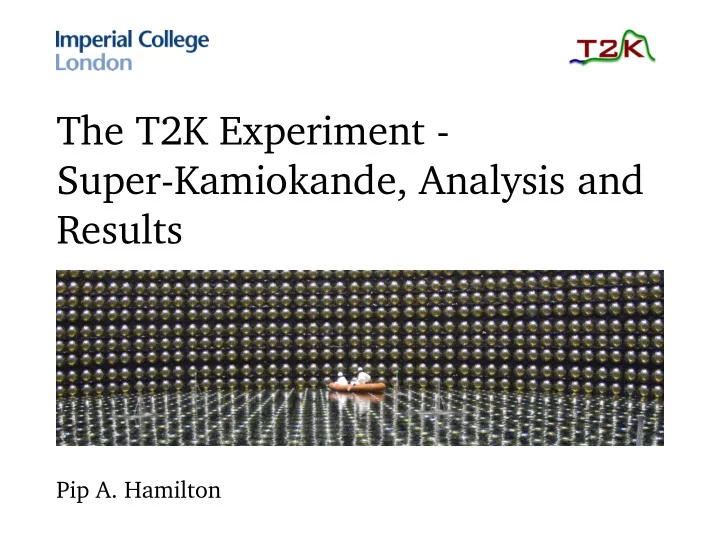

The T2K Experiment - Super-Kamiokande, Analysis and Results Pip A. Hamilton
Contents 1. The Super-K Detector 2. Analysis 2.1 Particle ID 2.2 Backgrounds ◮ Backgrounds external to the beam ◮ Backgrounds within the beam 3. Results 4. Summary The T2K Experiment Pip A. Hamilton 22nd February 2012 2
Super-Kamiokande ‘Super-K’ – water-based Cherenkov detector under Mt. Ikeno, Japan. ◮ 50,000 tonnes of ultra-pure water ◮ 11,129 inward-facing PMTs ◮ Inner volume of > 8 CMS detectors Successor to the first KamiokaNDE detector – designed originally to look for proton decays. The T2K Experiment Pip A. Hamilton 22nd February 2012 3
◮ Inner volume surrounded by outer detector ◮ Provides passive shielding (2m of water) against background from cavern walls ◮ Instrumented to veto cosmic rays ◮ ν e / ν µ strike nuclei in H 2 O, produce e − / µ − via weak charged-current (CC) interactions. ◮ Passage of leptons through detector produces Cherenkov light, picked up by the PMTs. The T2K Experiment Pip A. Hamilton 22nd February 2012 4
Analysis Method Large overlap in methodology between ν µ disappearance and ν e appearance studies: I will focus on ν e appearance. ◮ Counting experiment: looking for ν e excess predicted from oscillation ◮ Must be able to distinguish ν e from ν µ ◮ Expect a small excess: important to understand all backgrounds contributing to the ν e signal The T2K Experiment Pip A. Hamilton 22nd February 2012 5
Particle Identification (PID) ◮ Muons travel cleanly through the detector ⇒ produce a single Cherenkov cone and a sharp ring of PMT hits on the detector wall. ◮ Electrons (being much lighter) scatter and shower ⇒ produce multiple overlapping cones and a fuzzy ring of hits. PID success rate ∼ 99 % The T2K Experiment Pip A. Hamilton 22nd February 2012 6
Backgrounds Backgrounds come in two categories: beam-related (dominant) and outside the beam. A series of selection cuts are applied to reduce both kinds (non-beam backgrounds reduced to estimated 0.003 events). There remain two main backgrounds from within the beam itself: ◮ Particle mis-ID → π 0 s from weak neutral-current (NC) interactions are primary culprits ◮ ν e contamination of the beam (NB: not as significant a background for ν µ disappearance, for obvious reasons) The T2K Experiment Pip A. Hamilton 22nd February 2012 7
NC π 0 background ◮ π 0 s produced through ν + N → ν + ∆ , ∆ → π 0 + N ◮ π 0 s decay via π 0 → γγ (BR 98 . 8 % ). ◮ Photons shower like electrons, producing similar Cherenkov rings. Analysis cuts on there being only one ring, but the γ s can still fake an electron signal if only one ring is seen, i.e. ◮ Energy of the photons is highly asymmetric ◮ Small opening angle, rings overlap ◮ One photon escapes without showering The T2K Experiment Pip A. Hamilton 22nd February 2012 8
Solution: Force reconstruction of two rings, cut on invariant mass. Coloured histograms are of MC predictions; blue line shows position of invariant mass cut (105 MeV). The T2K Experiment Pip A. Hamilton 22nd February 2012 9
ν e contamination ν µ beam contaminated from outset with small proportion of ν e s via two processes: ◮ µ + → e + ν e ¯ ν µ , from the muons produced in the pion decays ◮ K + → π 0 e + ν e (BR ∼ 5 % ), from kaons produced alongside the pions Background from kaon decays can be reduced by a cut on the maximum energy (have wider energy spectrum). The T2K Experiment Pip A. Hamilton 22nd February 2012 10
Results The T2K Experiment Pip A. Hamilton 22nd February 2012 11
The T2K Experiment Pip A. Hamilton 22nd February 2012 12
θ 13 � = 0 The T2K Experiment Pip A. Hamilton 22nd February 2012 13
Summary 1. Described Super-K detector 2. Identified main backgrounds ◮ External ◮ Intrinsic to beam 3. Shown how these backgrounds are controlled 4. Shown first physics results! ◮ Strong indication that θ 13 � = 0 Data taking should resume from March. The T2K Experiment Pip A. Hamilton 22nd February 2012 14
Backup Slide: Background Cuts Non-beam: ◮ No activity in the outer detector ◮ 100 µ s acceptance window before/after arrival time Beam: ◮ Interaction vertex must lie in the fiducial volume (2m in from detector wall) ◮ Minimum reconstructed neutrino energy of 100 MeV ◮ No delayed electron from muon decay (for ν e study) The T2K Experiment Pip A. Hamilton 22nd February 2012 15
Recommend
More recommend